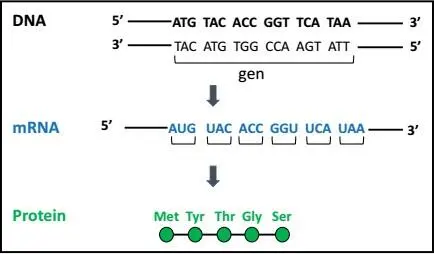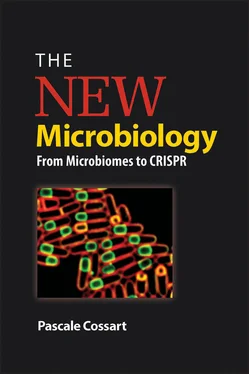Bacterial cell biology is a new discipline that will allow the understanding of bacterial physiology in previously unobtainable detail. It will undoubtedly result in understanding important issues such as the persistence of pathogenic bacteria or the proliferation of some bacteria in certain environments.
CHAPTER 3
The RNA Revolution
Genes of a bacterium—its genetic ID card that distinguishes it from other bacteria—are, like our own, carried by the DNA of its chromosome. Bacterial chromosomes are usually circular in shape. Generally, bacteria have a single chromosome, though some bacteria such as Vibrio cholerae have two, and other uncommon genera can have more. Borrelia , which is carried by ticks and causes Lyme disease, has many linear chromosomes.
Many bacteria, in addition to their main chromosomes, also have circular minichromosomes called plasmids . These chromosomes are not essential to bacterial multiplication but nevertheless may play a significant role in bacterial survival and pathogenicity.
The DNA of a chromosome or a plasmid is a two-stranded polymer. Each strand is a succession of nearly identical components called nucleotides , made of a base plus a sugar, that differ only in their base: A, T, G, or C (adenine, thymine, guanine, and cytosine). The two strands of the DNA twist around each other in a helical ladder owing to the affinity of A for T and of G for C. The genes situated along the chromosome are made up of hundreds, sometimes thousands, of nucleotides. They carry within them the information needed to synthesize proteins. In other words, these genes encode proteins. In between the genes are found “intergenic” sequences of nucleotides that do not encode proteins.
The DNA present in bacteria is either identically copied or “read.” In the first case, the process of replication , both strands of the DNA are duplicated exactly, to be passed on to the daughter cells during cell division. In the second case, during transcription , the information carried on one DNA strand is “read” by a mechanism that creates a similar but different molecule called a transcript RNA molecule, a messenger RNA (mRNA) ( Fig. 5). It is called “messenger” because it carries a message from the chromosome that will allow the cell to make a protein. RNAs typically have only one strand of ribonucleotides composed of one base and one sugar, as in DNA, but the four bases in RNA are A, U (for uracil), G, and C. RNAs contain the sugar ribose (which gives RNA its name, ribonucleic acid), whereas DNA has deoxyribose (which likewise gives DNA its name, deoxyribonucleic acid).
Replication begins in the part of a chromosome called the origin of replication and moves in two directions along the chromosome. As the chromosome is composed of two strands of DNA, each is thus duplicated. Once replication begins, the whole chromosome is replicated. Transcription, in contrast, is a process that moves in one direction only. It can begin at any point in a chromosome but only “upstream” of the gene(s) being transcribed, in regions that François Jacob and Jacques Monod named promoters . Only certain regions of each DNA strand are transcribed onto RNA. The RNA transcript—the mRNA—is then read during translation.

Figure 5. Schematic representation of a double strand of DNA, of its transcribed messenger RNA (mRNA), and of the small protein encoded by the mRNA.
Translation is a fairly sophisticated process that is achieved by several bacterial actors and in particular a big machine called the ribosome. Ribosomes read the nucleotide sequence of the mRNA transcript by recognizing successive triplets of nucleotides or codons . Each of the 64 possible triplets of nucleotides (AUG, UAC, or ACC, for example) corresponds to one of the 20 amino acids that are the building blocks for proteins; thus each amino acid can be encoded by more than one codon. This genetic code is the same for all bacteria and most other organisms. Thus, from their DNA, bacteria produce RNA that is ultimately translated into proteins by this universal code. Bacteria produce thousands of mRNAs, each of which produce proteins.
The results that led François Jacob, André Lwoff, and Jacques Monod to their 1965 Nobel Prize in Physiology or Medicine concerned the discovery that several successive genes, generally involved in the same physiological function, are transcribed together from a single promoter in a single mRNA and thus form a cluster of coregulated genes that they termed an operon .
Transcription is not a permanent process. It depends on many environmental factors (such as pH or temperature). It also depends on bacterial factors. In the simplest situation, transcription is regulated by a single “regulator” protein encoded by a gene situated elsewhere on the chromosome. This regulator interacts with the DNA region located upstream of the first gene of the operon; it can either prevent (“repress”) or stimulate the expression of mRNA. This model of regulation was studied by François Jacob and his colleagues in the lactose ( lac ) operon, which is involved in the utilization of the sugar lactose, in Escherichia coli . The lac operon in E. coli encodes, among other things, the lactose-metabolizing protein LacZ. Transcription of the lac operon is generally repressed, or silenced, because the protein LacI (also called the Lac repressor) binds to the chromosome upstream of the lac operon genes and prevents that DNA from being read. When lactose is present in the bacterium’s environment, the organism can convert it into allolactose, a molecule that binds to and alters the form of the repressor LacI protein (a conformation, or allosteric change) and prevents it from binding to the DNA. In the absence of LacI repression, the lac operon genes are transcribed and then translated, allowing the organism to metabolize lactose.
Many researchers have forgotten that in the original model for the operon published in the Journal of Molecular Biology in 1961, Jacob and Monod proposed that the repressor is the product of a regulatory gene—that is, an RNA repressor that would act either in a region of the DNA upstream of the operon, to repress its transcription, or at the start of the operon mRNA, to prevent translation of the message ( Fig. 6). Following the publication of this model, researchers analyzed in detail the regulation of the lactose operon and found that the Lac repressor is not in fact an RNA molecule but instead a protein that works upstream of operon genes, as discussed earlier. For years, this discovery was followed by numerous successful discoveries of other repressors, forgetting a key part of Jacob and Monod’s hypothesis— repressors could also be RNA.
Repressors and activators
The operon model has been shown to occur in all bacteria, other prokaryotes, and some eukaryotes (particularly in worms such as the nematode Caenorhab-ditis elegans) . It has thus been refined and enriched. We now know that genes can be repressed by a variety of repressors that more or less resemble the Lac repressor. Certain genes can be repressed by several repressors but others may also be activated. In this case, it is not a negative regulation that occurs, as for the lac operon, but a positive regulation, with an activator protein that binds upstream of the operon when specific conditions require genes to be expressed. One of the best-known activator proteins in bacteria is the protein CAP or CRP in Escherichia coli , which binds cyclic AMP , a molecule that acts as a hormone and can activate genes involved in the use of sugars other than glucose in bacteria.
Читать дальше












